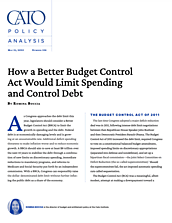1. Budget Control Act of 2011, Pub. L. No. 112–25 (2011), Congress.gov, last updated August 2, 2011.
2. Douglas W. Elmendorf, “Estimated Impact on the Deficit of the Budget Control Act,” letter to speaker of the House and majority leader of the Senate, Congressional Budget Office, August 1, 2011.
3. Megan S. Lynch and Grant A. Driessen, “Expiration of the Discretionary Spending Limits: Frequently Asked Questions,” Congressional Research Service, November 18, 2022; and Yuval Rosenberg, “Was the Budget Control Act a ‘Colossal Failure’?,” Fiscal Times, August 12, 2019.
4. “What Would It Take to Balance the Budget? An Update,” Committee for a Responsible Federal Budget, February 24, 2023.
5. Romina Boccia, “The GOP Wants to Return Discretionary Spending to FY2022 Levels: A Brief Analysis,” Cato at Liberty (blog), Cato Institute, January 25, 2023.
6. Romina Boccia and Dominik Lett, “Emergency Spending Is on the Rise: Here’s How Congress Can Stop It,” Cato at Liberty (blog), Cato Institute, December 20, 2022.
7. Romina Boccia, “Can a Commission Reform Social Security and Medicare?,” Cato at Liberty (blog), Cato Institute, February 22, 2023.
8. Jack Salmon, “The Impact of Public Debt on Economic Growth,” Cato Journal 41, no. 3 (Fall 2021): 487–509.
9. John Mantus and Mark J. Warshawsky, An Expanded and Updated Analysis of the Federal Debt’s Effect on Interest Rates (Washington: American Enterprise Institute, September 2022); Congressional Budget Office, The 2022 Long-Term Budget Outlook (Washington: Congressional Budget Office, July 2022); and Romina Boccia and Dominik Lett, “The Debt Limit and the High Costs of Debt,” Cato at Liberty (blog), Cato Institute, February 1, 2023.
10. Romina Boccia, “Zombie Spending That Just Won’t Die,” Cato at Liberty (blog), Cato Institute, September 8, 2022.
11. Downsizing the Federal Government (website), Cato Institute, accessed April 7, 2023; “Budget Blueprint for Fiscal Year 2023,” Heritage Foundation, accessed April 7, 2023; “Fix the National Debt,” Committee for a Responsible Federal Budget, accessed April 7, 2023; “2022 Prime Cuts,” Citizens against Government Waste, October 27, 2022; and Demian Brady and R. J. Cross, “Toward Common Ground: Bridging the Political Divide with Deficit Reduction Recommendations for Congress,” National Taxpayers Union Foundation and U.S. Public Interest Research Group, April 23, 2020.
12. Congressional Budget Office, Options for Reducing the Deficit: 2021 to 2030 (Washington: Congressional Budget Office, December 2020).
13. Romina Boccia and Justin Bogie, Reform the Budget Control Act Spending Caps (Washington: Heritage Foundation, November 1, 2017).
14. Romina Boccia and Dominik Lett, “Emergency Spending Is on the Rise: Here’s How Congress Can Stop It,” Cato at Liberty (blog), Cato Institute, December 20, 2022.
15. Romina Boccia, “Needed: An Effective Fiscal Framework to Restrain Spending and Control Debt in the United States,” Heritage Foundation, December 19, 2018.
16. Romina Boccia and Dominik Lett, “The CBO Budget and Economic Outlook in the Post‐COVID Fiscal Era,” Cato at Liberty (blog), Cato Institute, February 15, 2023.
17. Romina Boccia, “The Unsustainable Burdens Posed by the So‐Called Medicare and Social Security Trust Funds,” Cato at Liberty (blog), Cato Institute, April 3, 2023.
18. Romina Boccia, “The Unsustainable Burdens Posed by the So‐Called Medicare and Social Security Trust Funds,” Cato at Liberty (blog), Cato Institute, April 3, 2023.
19. Romina Boccia, “Medicare and Social Security Are Responsible for 95 Percent of U.S. Unfunded Obligations,” Cato at Liberty (blog), Cato Institute, March 28, 2023.
20. The trust funds are technically empty. They are merely ledgers for federal government borrowing. However, the special-issue Treasury bonds they hold allow the Treasury Department to borrow from the public to finance benefits. In that sense, they are meaningful for setting congressional action–forcing deadlines.
21. Government Accountability Office, Entitlement Reform Process: Other Countries’ Experiences Provide Useful Insights for the United States (Washington: Government Accountability Office, January 2008).
22. Ashley Gabriele and Darrell M. West, Ten Leadership Lessons from Simpson-Bowles (Washington: Brookings Institution, November 14, 2012).
23. Romina Boccia, How Congress Can Improve Government Programs and Save Taxpayer Dollars (Washington: Heritage Foundation, June 10, 2014).
24. Stuart M. Butler and Timothy Higashi, Redesigning the Budget Process: A Role for Independent Commissions? (Washington: Brookings Institution, October 23, 2018).


